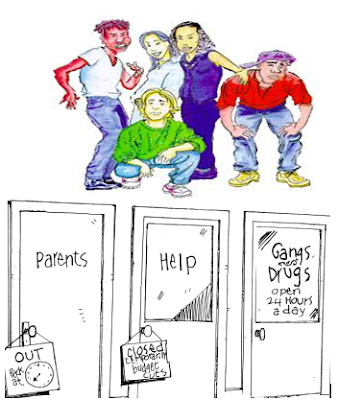The future of youth gangs seems continuous without an immediate end in sight, especially in impoverished areas since they have to worry about potential harm and injuries because of gang presence being forced to use aggression to fend off future violence. Often times when family members promote negative norms that the youth views as valid, results in them growing up accepting false and hazardous norms, causing the perpetuation of violent crimes in a community, which can lead to false ideologies being passed down from generation to generation. Many times the lack of motivation for the youth to aspire to do something positive in their life and continue going to school is missing, because of that consequently kids do not aim high with their life goals and settle for anything that is handed to them. When gangs exist in a community, they can seriously impact anything and everything especially neighborhoods, using them as recruitment centers and claiming some areas as gang territory. As a result of the gang presence, belonging to a gang at times is a type of self-protection employed by the youth in response to threatening environments and communities, resulting in and endless gang cycle without an end in sight.
Responses by the government to combat this problem have proven ineffective. Although law enforcement agencies have created tasks forces and other countermeasures to alleviate the gang problem, since each gang operates autonomously few prevention and intervention techniques have worked across the board. The California Gang Reduction, Intervention and Prevention Program (Gov.CA. Gov, 2011), which treats violent gang members like High-Risk Sex Offenders. High risk gang parolees are subject to special parole conditions that limit their ability to recruit children into gangs and limit their access to areas that have a strong gain presence. Offenders convicted of gang-related offenses will be evaluated for High Risk Gang Offenders (HRGO) status prior to release. Local law enforcement will be notified before High Risk Gang Offenders are released into their neighborhood in the same manner they receive notice of high risk sex offenders (Gov.CA.Gov, 2011). Program such as these are expected to aid in the eradication of gangs, and their violence. With all these measures in place, gangs, and the violence gangs cause continue to plague communities.
It is important to recognize the community factors that contribute towards a culture of violence that range from: housing, the media, and educational system. Most of these at-risk youths grew up living in urban areas with high poverty and crime rates, because of this type of environment the youth frequently interact and are around violence which contributes to their negative behavior. These youths begin to adapt this violent behavior since they see it as a norm in their everyday life. They are surrounded by this type of environment and do not have other outlets around them that will teach them “acceptable behavior,” so they continue to act in unacceptable ways and internalize it as acceptable behavior which will eventually be taught to their kids. “Local street gangs, or neighborhood-based street gangs, remain a significant threat because they continue to account for the largest number of gangs nationwide. Most engage in violence in conjunction with a variety of crimes, including retail-level drug distribution” (National). Recognizing and accepting that the great majority of youths who join gangs most often than not come from low income communities can help to pinpoint the problem areas that would need the most help to try and reduce gang violence as well as gang membership and try to stop this cycle from repeating itself.
The future of youth gangs seems continuous without an immediate end in sight. Gangs have existed for hundreds of years, and will continue to exist in one form or another unless we dedicate the time and money that is really required to try and stop them. In order to ensure that the violence and negative aspects of gangs diminishes, we must focus on preventative measures and ensure that the youth stay away from gangs and help them aspire to do something big in their life and have high expectations for themselves. Stopping youth gangs and violence is not going to be an easy or quick task to do, but it is one that we must take very seriously if we wish to reduce the violence in America and ensure that the future generation grows up to be something big and make a difference in this world.
Sources:
Office of the Governor. Retrieved April 24, 2011 from www.gov.ca.gov
"National Gang Threat Assessment 2009." United States Department of Justice. Jan.2009. Web. 25 Apr. 2011.<http://www.justice.gov/ndic/pubs32/32146/index.htm>.



